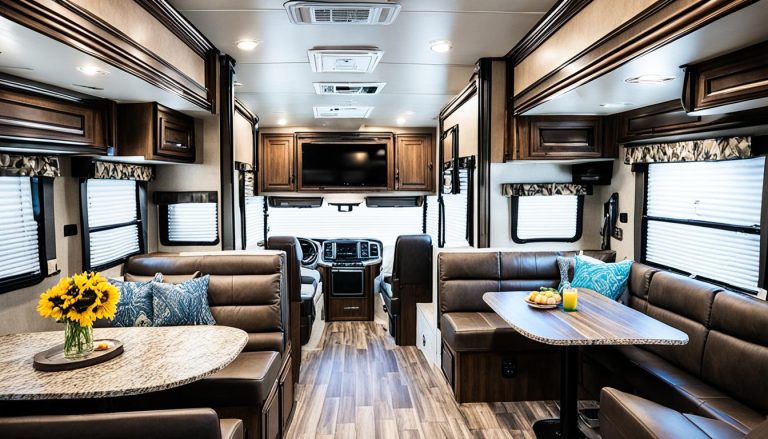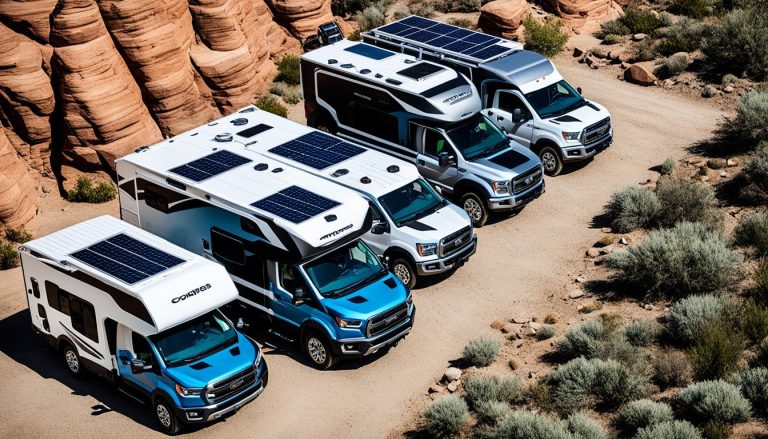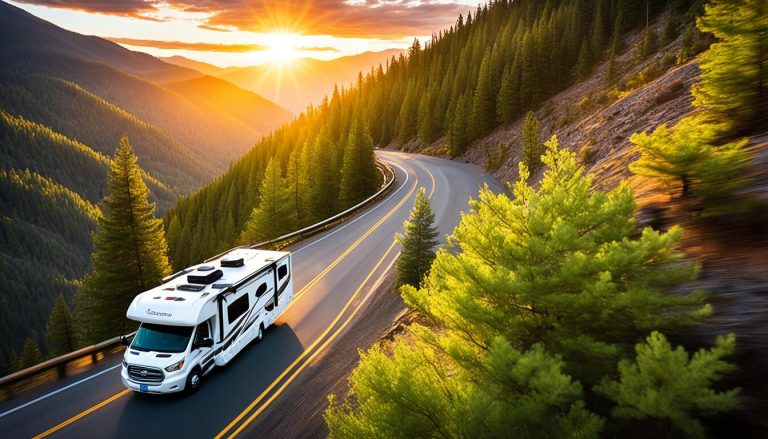Ultimate Guide to Fifth Wheel Trailer Hitches
gorvlifestyle.com and its partners may earn a commission if you purchase a product through one of our links
For those who cherish the open road and the freedom of travel, fifth wheel trailer hitches are the unsung heroes of your grand adventures. Whether it’s navigating cross-country journeys or enhancing your vocational capabilities, selecting the best fifth wheel hitch for your towing needs is paramount. With a plethora of products on the market, sifting through fifth wheel hitch reviews can be daunting. Yet, it’s essential to determine which system will reliably cradle your precious cargo wherever the wind may take you. This insightful narrative elucidates everything from the necessity of matching towing capacities to finding top rated fifth wheel hitch models that stand the test of time and terrain. The aim? To equip you with a profound understanding that transforms the complexity of choices into a cohesive, easy-to-navigate buying guide fifth wheel hitch tailored for your lifestyle and budget.
Key Takeaways
- Selecting the right fifth wheel trailer hitch ensures safe and stable towing experiences.
- Understanding truck towing capacities and bed lengths is critical for hitch compatibility.
- Reviews and ratings are invaluable resources for assessing hitch quality and performance.
- Exploring puck systems and their advantages can lead to a more streamlined installation process.
- Maintaining your fifth wheel hitch is necessary for optimal functionality and longevity.
- Investing in a highly-rated hitch aligns with safety standards and peace of mind.
Understanding the Basics of Fifth Wheel Trailer Hitches
Exploring the fundamentals of fifth wheel trailer hitches is essential for anyone looking to enhance their towing experience. These robust hitches are the cornerstone for secure and efficient towing of sizable trailers, and understanding their mechanics, benefits, and installation processes is key to a successful journey.
Defining Fifth Wheel Trailer Hitches
A fifth wheel trailer hitch is a heavy-duty coupling apparatus, designed to connect a pivot vehicle, like a pickup truck, with a large trailer or caravan. Mounting securely to the bed of the truck, it employs a kingpin mechanism for an articulated joint, facilitating smoother and more reliable towing compared to regular ball hitches. It’s no surprise that a high-quality heavy duty fifth wheel hitch is a top choice for recreational travel enthusiasts who demand performance and safety.
Advantages of Using a Fifth Wheel Hitch
The enhanced maneuverability and additional carrying capacity proffered by fifth wheel hitches far outweigh the capabilities of traditional hitches. This added mobility is vital for navigating curves on the open road, while the extra loading space is a boon for travelers. It’s no wonder, then, that those seeking affordable fifth wheel hitches can still revel in the extensive benefits without compromising their budget.
Components of a Fifth Wheel Hitch System
The anatomy of a fifth wheel hitch system is straightforward yet innovative, comprising the hitch head, which secures the kingpin from the trailer; the mounting rails, acting as the foundation attached to the truck bed; and the installation brackets that hold the assembly in place. For trucks fitted with it, the puck system comes into play, offering an elegant solution to the fifth wheel hitch installation process. Such a system allows for a quick and tool-free installation, reaffirming fifth wheel hitches as the pinnacle of towing technology.
Evaluating Your Towing Vehicle’s Capabilities
When preparing for the adventures that lie ahead, it’s paramount for enthusiasts of the outdoors to understand the strengths and limitations of their towing vehicles. This comprehension is crucial when selecting the best fifth wheel hitch for your excursions. Beginning with an assessment of your truck’s intrinsic abilities sets the foundation for a smooth towing experience.
Identifying Your Truck’s Towing Capacity
Embarking on this journey requires a clear picture of your truck’s towing capacity, which serves as the linchpin for towing safely and efficiently. It is the bedrock upon which safe towing practices are built, ensuring that every trip made with your fifth wheel trailer is within the mechanical harmony of your vehicle’s design. This capacity is not just a mere suggestion but an engineering boundary that should not be crossed.
To complement the process of identifying your truck’s towing capacity, routine fifth wheel hitch maintenance is indispensable. It is the due diligence that prolongs the life of the hitch and mitigates any potential hazards. Let’s delve into a breakdown of weight considerations relevant to your truck’s capacity:
| Truck Model | Towing Capacity | Recommended Fifth Wheel Hitch |
|---|---|---|
| Ford F-250 | 15,000 lbs | CURT A-Series |
| Chevrolet Silverado 2500 | 14,500 lbs | Reese Pro Series |
| Ram 3500 | 18,000 lbs | B&W Companion |
| GMC Sierra 3500 | 16,000 lbs | Demand Defender |
Importance of Gross Trailer Weight (GTW)
The Gross Trailer Weight (GTW) stands as a sentinel, always reminding transporters never to exceed the prescribed weight limit. It is a combination of your trailer’s weight plus its loaded contents and is profoundly fundamental in the selection of a fifth wheel hitch. Not knowing the GTW would akin to navigating treacherous roads blindfolded. Therefore, determining your vehicle’s GTW with precision is a pillar in trailering safety and assurance.
Choosing a hitch that is tailored to your vehicle’s GTW is synonymous with choosing the path of reliability. This harmony between the best fifth wheel hitch and your truck’s specifications is a requisite for road safety and the prevention of damage to your cherished vehicle.
Remember, towing isn’t merely about getting from point A to point B—it’s about ensuring that every journey you embark upon is within the safe embrace of your vehicle’s towing capabilities, complemented by a reliable fifth wheel hitch. Take the time to assess, compare, and maintain, so that every road taken is a testament to foresight and preparation.
Fifth Wheel Trailer Hitches and Truck Bed Lengths
When selecting a fifth wheel hitch, the bed length of your truck plays a pivotal role. The industry has solutions tailored specifically to match the size of your vehicle, ensuring safety and ease during your towing adventures. Understanding the relationship between truck bed length and hitch type is essential for proper fifth wheel hitch installation and to benefit from accurate fifth wheel hitch reviews.
Short-Bed Trucks Versus Long-Bed Trucks
Owners of short-bed trucks must navigate the challenge of limited space between the truck cab and the fifth wheel trailer. To avoid the risk of the trailer striking the cab on sharp turns, sliding hitches are recommended for these vehicles. They provide the additional clearance necessary during maneuvering. Conversely, long-bed trucks, with their extensive bed space, are typically better suited for fixed hitches, which remain stationary and offer consistent performance and simplicity.
Considering Clearance for Maneuverability
Accurate clearance is a critical factor in preventing accidents and ensuring seamless towing. The formula for determining necessary clearance is simple: measure half the trailer’s width and subtract the distance from the cab to the pivot point of the fifth wheel hitch. This calculation guides drivers in choosing between a mount with legs—ideal for long beds—or the versatile sliders for short beds.
Explore the nuanced world of fifth wheel hitches to ensure your set-up is optimized for your truck’s specifications. Below is an insightful table outlining the recommendations based on bed length:
| Truck Bed Length | Recommended Hitch Type | Clearance Advantages |
|---|---|---|
| Short-Bed | Sliding Hitch | Prevents cab-trailer collision during turns, offers flexible positioning |
| Long-Bed | Fixed Hitch | Stable towing experience, no need for additional clearance mechanisms |
For more detailed fifth wheel hitch reviews, highlighting the strengths and weaknesses of various models for different truck bed lengths, and personalized fifth wheel hitch installation guidance, always consult with experienced professionals or the hitch manufacturer.
Exploring the Puck System Advantage
The innovative puck system signifies a leap forward in the realm of towing technology, offering remarkable convenience and facilitating the fifth wheel hitch maintenance process. For truck owners seeking an affordable fifth wheel hitch with hassle-free installation, a puck system is a definitive game-changer worth exploring.
What is a Puck System?
At the heart of the puck system lies a built-in mounting assembly integrated into the truck’s bed by manufacturers, designed specifically for towing. The system typically consists of a set of four to six anchoring points, known as pucks, arrayed around a central gooseneck hole. Notable for the ease it brings to the installation process, the puck system eliminates the need for drilling and other complicated hardware setups.
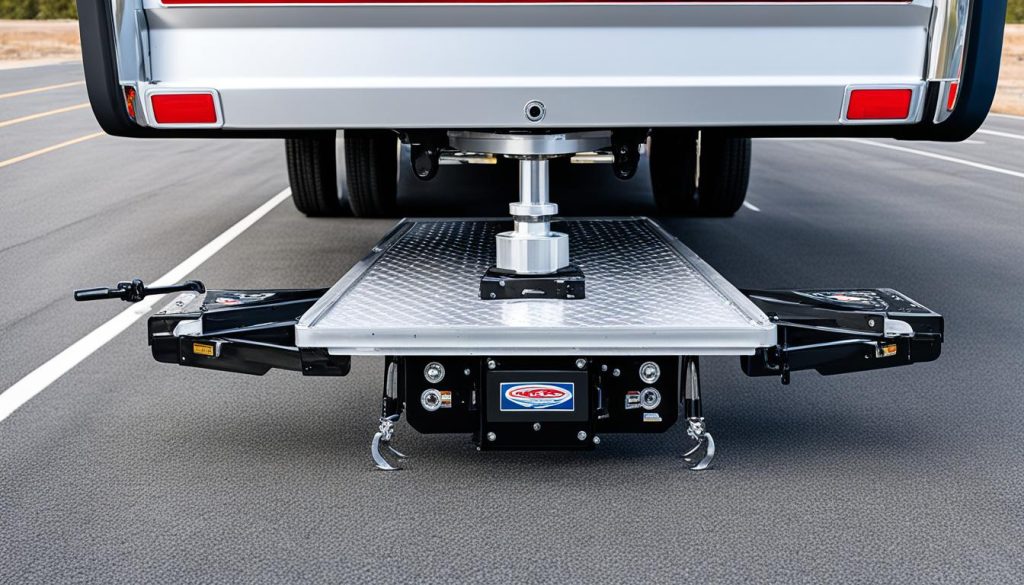
Compatibility and Vehicle-Specific Considerations
Finding the right match between a fifth wheel hitch and your truck’s puck system hinges on compatibility. Automakers such as Chevrolet, Ford, GMC, Nissan, and Ram have embraced this mounting technology, offering it across various models. To harness the full potential of this seamless integration, one must select a hitch that dovetails perfectly with the vehicle’s Original Equipment Manufacturer (OEM) puck system specifics.
Frequent fifth wheel hitch maintenance is crucial for ensuring prolonged and reliable performance, and the puck system supports this by streamlining the process, making it more accessible to truck owners. When it’s time to choose a new or replacement towing apparatus, opting for an affordable fifth wheel hitch that aligns with your vehicle’s puck system can save you both time and effort, ultimately reflecting a smart and future-proof investment in your towing setup.
Selecting the Right Fifth Wheel Hitch for Your Truck
Choosing the appropriate fifth wheel hitch for your vehicle entails examining a multitude of factors to ensure safety and optimal performance. This buying guide is designed to help you navigate through the top rated fifth wheel hitch options and make an informed decision based on your specific requirements. Let us delve into the CURT series of hitches, which are well-regarded in fifth wheel hitch reviews.
- Consider the weight capacity: Ensure the hitch can support the weight of your trailer.
- Account for truck bed length: Determine whether you need a sliding or stationary hitch.
- Check for puck system compatibility: Aim for a hitch that works seamlessly with your truck’s existing setup.
- Rail type preference: Decide between removable or permanent rails according to your usage.
Below, find a curated list of hitches from the CURT series:
| Series | Features | Weight Capacity | Compatibility |
|---|---|---|---|
| A-series™ | Articulating head design, cast yoke | 20,000 to 25,000 lbs | Sidewinder compatible |
| Q-series™ | Quiet operation, spherical axial bearing | Up to 24,000 lbs | Sidewinder compatible |
| E-series™ | Economical choice, dual-pivoting head | 15,000 to 16,000 lbs | Limited Sidewinder compatibility |
Each CURT hitch series brings a set of features that cater to different towing scenarios, from recreational travels to heavy-duty hauling. It’s these distinctions that you’ll want to consider closely when perusing fifth wheel hitch reviews. When you align your choice with your vehicle’s specifications and intended use, you lay the groundwork for safe, reliable towing adventures.
How to Measure for Proper Fifth Wheel Hitch Fit
Finding the right fit for your fifth wheel trailer hitches hinges on accurate measurement and understanding your truck’s specific dimensions. Whether you’re planning a fifth wheel hitch installation yourself or seeking professional assistance, these guidelines ensure that your hitch will be a reliable connection for your travels.
Measuring Truck Bed Length: Start by determining the length of your truck bed. This is the distance between the bulkhead and the tailgate. Truck beds are typically categorized as short (usually around 5.5 to 6.5 feet) or long (around 8 feet), and knowing this measurement is crucial for selecting the appropriate heavy duty fifth wheel hitch.
Short-Bed Trucks: If you have a short-bed truck, you’ll need to measure the distance from the back of the truck cab to the axle. This distance affects the hitch’s position and the clearance needed for making turns without risking a collision between the cab and trailer.
Long-Bed Trucks: These offer more flexibility and typically do not require a slider hitch for additional clearance during turning. A fixed fifth wheel hitch is often sufficient for long-bed trucks.
Additional Measurements: Don’t forget to measure the height from the bed to the trailer plate—that’s the base of the kingpin—and the width of the trailer to calculate if your truck can accommodate the trailer without any risk of damage while turning or maneuvering.
| Measurement Type | Short-Bed Trucks | Long-Bed Trucks |
|---|---|---|
| Truck Bed Length | 5.5 – 6.5 feet | Approx. 8 feet |
| Clearance Required | Must ensure enough space for turns | Typically sufficient as is |
| Type of Hitch Recommended | Slider Hitch for added mobility | Fixed Hitch |
| Height from Bed to Trailer Plate | Measure to ensure hitch can couple securely | |
| Trailer Width | Ensure truck bed can accommodate without interference | |
With these measurements in hand, you’ll be primed to select a hitch that provides not just a snug fit, but also the peace of mind that comes with knowing your setup is optimized for safety and stability on the road.
Installing a Fifth Wheel Hitch: Steps You Need to Know
Setting up a fifth wheel hitch on your truck can enhance your towing experience, making it safer and more reliable. Whether you’re opting for the best fifth wheel hitch to tow a luxurious RV or an affordable fifth wheel hitch for occasional use, it’s important to know the installation process. Proper fifth wheel hitch maintenance begins with a correct installation.
Before starting, gather all necessary tools, which typically include:
- Socket set
- Crescent wrench
- Torque wrench
- Ratchet and drill with bits
- Tape measure
After assembling your tools, follow these key steps to install your fifth wheel hitch:
- Stabilize the vehicle to ensure it’s safe to work underneath and on the truck bed.
- Position the base rails in the truck bed, following the measurements provided in the manufacturer’s guide.
- Anchor the base rails to the truck bed, carefully drilling if necessary, and secure with the hardware included.
- Attach the hitch to the mounted base rails, ensuring it’s aligned correctly and bolted tightly.
- Double-check all connections and torque to the specifications recommended by the hitch manufacturer.
The installation time may vary, but give yourself about 6 hours to complete the task. If you’re not confident with the installation process, consider seeking professional help to ensure safety and correctness.
Below is a comparison of two popular fifth wheel hitches which outlines their key features:
| Feature | CURT A-series™ | CURT E-series™ |
|---|---|---|
| Head Design | Articulating head | Fixed head |
| Mounting System | Compatible with puck system | Traditional rail-based installation |
| Ideal for Bed Length | Works with all lengths | Long-bed trucks |
| Price Point | Higher, for frequent towing needs | More affordable, for less frequent use |
Remember that regular maintenance checks post-installation are vital to ensure the hitch remains in top condition. Adhering to the manufacturer’s guidelines for both installation and maintenance will help prolong the life of your fifth wheel hitch and provide you with many miles of smooth, secure towing.
Maintenance Tips for Fifth Wheel Hitches
When it comes to reliable towing, fifth wheel hitch maintenance is a top priority for ensuring that your vehicle’s towing system operates safely and efficiently. Without regular check-ups and upkeep, the performance of even the top rated fifth wheel hitch might degrade over time, potentially leading to dangerous towing conditions. Therefore, hitch owners must establish a regular maintenance routine to keep their towing adventures free from unexpected setbacks.
Maintaining your fifth wheel hitch is essential for safe and reliable towing. Regular checks and care keep everything working as it should and can minimize the risk of accidents.
Below is a comprehensive guide to maintaining your fifth wheel hitch, ensuring you’re never caught off guard while on the road:
- Conduct a visual inspection for any signs of wear and tear before and after each trip, particularly looking for cracks or rust on the hitch itself.
- Ensure that all moving parts, such as the jaws and the pivot head, are well-lubricated to prevent sticking or seizing during operation.
- Double-check that all fasteners are tightened to the manufacturer’s specifications to prevent any loosening that could affect the hitch’s stability.
- Verify that the kingpin and locking mechanism are free from damage and debris, confirming a secure connection every time you hitch up.
- Assess the overall state of the electrical components, such as the brake and signal connections, to ensure they’re functioning properly.
Additionally, record keeping of your fifth wheel hitch maintenance can keep you aware of the hitch’s history and indicate when it’s time for a more thorough examination or a replacement. The table below offers a suggested maintenance schedule for a typical fifth wheel hitch:
| Maintenance Task | Frequency | Notes |
|---|---|---|
| Visual Inspection | Before/After Each Use | Check for visible damage or excessive wear. |
| Lubrication | Every 6 Months | Use recommended lubricants only. |
| Tighten Fasteners | Annually | Consult the manufacturer’s torque specifications. |
| Check Electrical Connections | Every Trip | Look for corrosion or loose wires. |
| Professional Inspection | Every 1-2 Years | Consider more frequent checks with heavy use. |
Following the above guidelines will not only help you maintain the structure and functionality of your hitch but also contribute to your peace of mind. Always refer to the manual provided by the hitch manufacturer for specific maintenance recommendations.
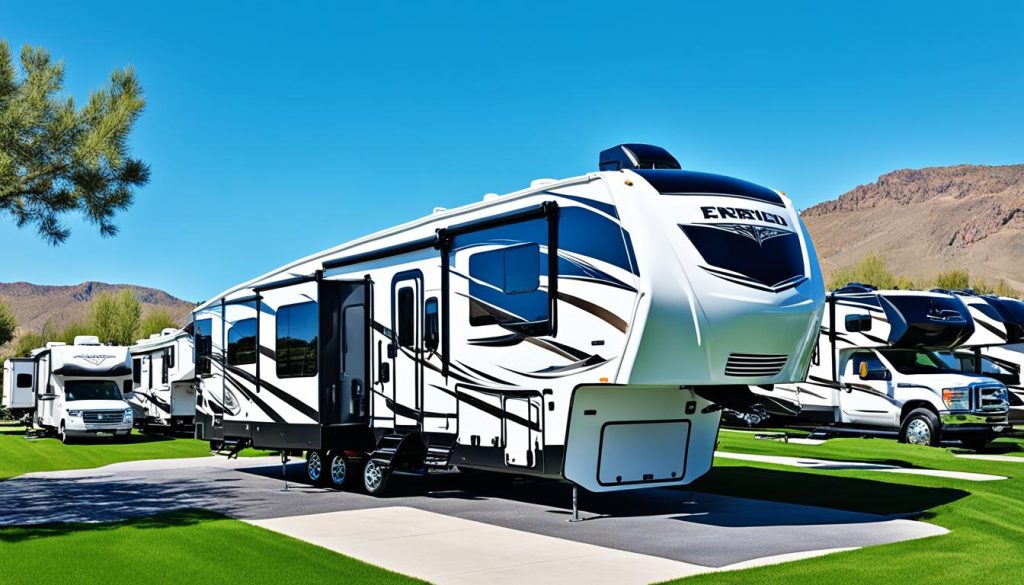
Remember, regular maintenance keeps your fifth wheel hitch in prime condition, ensuring countless successful journeys and a hitch that lasts throughout the many miles of adventure ahead.
The Role of Weight Capacity in Hitch Selection
For those in the market for a heavy duty fifth wheel hitch, understanding the importance of weight capacity is paramount. The hitch’s weight capacity must be suitable for your towing needs to ensure the safety of your vehicle and trailer alike. Clinching a hitch with the adequate weight limit is not a luxury but a necessity. Reviews suggest that drivers often overlook this factor, only to encounter challenges later.
When sifting through fifth wheel hitch reviews, prospective buyers will notice that hitches, like the CURT PowerRide™ and CrossWing™, have weight ratings that are meant to accommodate a range of towing scenarios, from lightweight trailers to heavy-duty cargo.
| Hitch Model | Weight Capacity | Best Use Scenario |
|---|---|---|
| CURT PowerRide™ | 30,000 lbs | Heavy commercial hauling, large RVs |
| CURT CrossWing™ | 20,000 lbs | Mid-size RVs, heavy domestic use |
Selecting a hitch that aligns or surpasses your vehicle’s towing capacity is crucial to maintain the integrity of your towing apparatus. With proper capacity assessment and alignment, drivers can confidently navigate the demands of the road, secure in the knowledge that their equipment is up to the task.
Fifth Wheel Hitch Correct Usage Practices
Maintaining high safety standards while traveling with a fifth wheel trailer hitch necessitates adherence to correct usage practices. Trailers equipped with the best fifth wheel hitch offer peace of mind when on the road, provided users follow established guidelines and conduct the necessary checks before embarking on their journeys. This section offers a closer look at how to ensure the hitch is used properly to avoid any mishaps.
Before setting off, it’s imperative to inspect each component of the fifth wheel trailer hitches. This inspection should include visual checks for any signs of wear or damage, as well as verification that all moving parts operate smoothly and the locking mechanisms are fully engaged.
- Ensure the kingpin is properly aligned with the hitch before attempting to connect the trailer to the truck.
- Double-check that the jaw or locking arm is secured, and there is no room for disengagement while the trailer is in motion.
- Follow the manufacturer’s instructions closely for engaging and releasing the coupling indicator and head removal.
Let’s explore the relationship between the hitch’s features and correct usage brands recommended for the fifth wheel trailer hitches:
| Feature | Correct Usage Practice |
|---|---|
| Kingpin Alignment | Ensure precise alignment with the hitch head; this reduces stress on the hitch and vehicle frame. |
| Jaw Locking Mechanism | Check that the jaw is secure and apply lubricant regularly for smooth operation. |
| Coupling Indicator | Regularly inspect the indicator for functionality and replace if necessary. |
| Accessory Compatibility | Only use accessories approved by the manufacturer and designed for your specific hitch model. |
Following these correct usage guidelines will not only prolong the life of the hitch but also protect both the vehicle and payload. Trusting a high-quality hitch from a recognized brand, one that is often cited as the best fifth wheel hitch, coupled with diligent practices, is the key to secure and reliable towing.
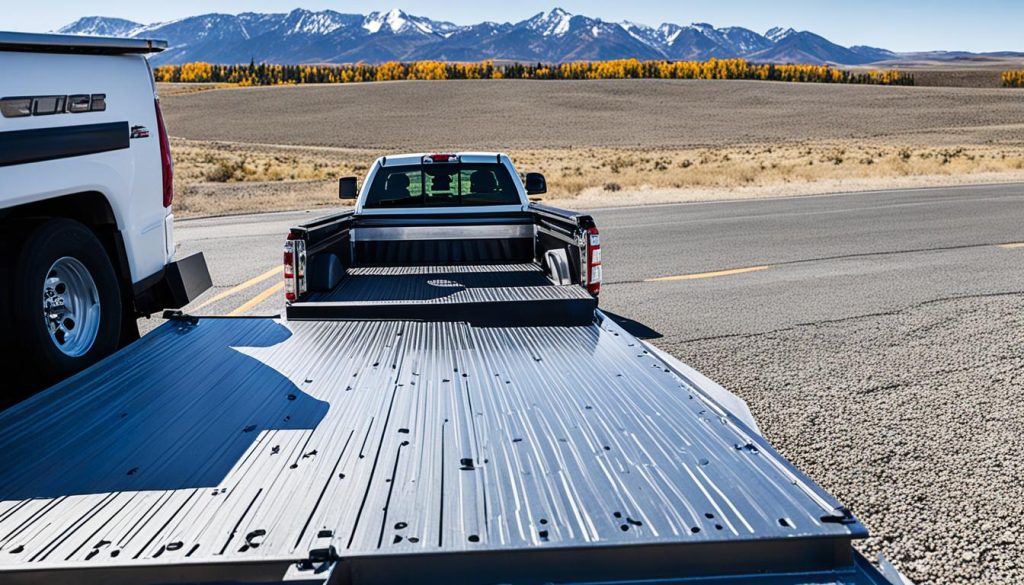
Remember that safe towing begins with the right equipment, but it is the attention to detail and adherence to best practices that ensure a stress-free experience. Take care of your equipment, and it will take care of you on the open road.
Advantages of Fifth Wheel Hitches Over Other Hitch Types
When it comes to towing, the superiority of fifth wheel hitches is apparent in comparison to other hitch types, such as gooseneck hitches. These hitches have become the go-to for many recreational vehicle enthusiasts due to their unrivaled ability to offer a smoother and more stable ride. This is significantly beneficial during extended travels where ride quality can impact both the comfort and safety of the journey. The distinctive kingpin and hitch design of fifth wheel variants play a pivotal role in their elevated stability, which is often highlighted in fifth wheel hitch reviews.
Moreover, owners of long bed trucks will find the fifth wheel hitch to be particularly advantageous. This hitch type is designed to facilitate optimal positioning between the cab and rear axle. This spacing is critical, providing the clearance needed for safe turning maneuvers, ensuring no complications arise during navigation, especially in tighter spaces. While the gooseneck hitch could be preferred for more industrial or agricultural towing needs, the fifth wheel hitch is the clear frontrunner for leisure and recreational usage because of its dependable stability and ease of maneuverability.
Lastly, cost is a consideration for many when selecting a hitch, and the market has responded with a variety of affordable fifth wheel hitch options. These budget-friendly choices do not skimp on quality, meaning safety and performance are not compromised for the sake of affordability. With a multitude of models available, there are hitches to fit the financial scope and specific requirements of almost any user. The merits of the fifth wheel hitch, underscored by continual innovation and favorable consumer feedback, make them an excellent choice for those looking to ensure a secure and enjoyable towing experience.

